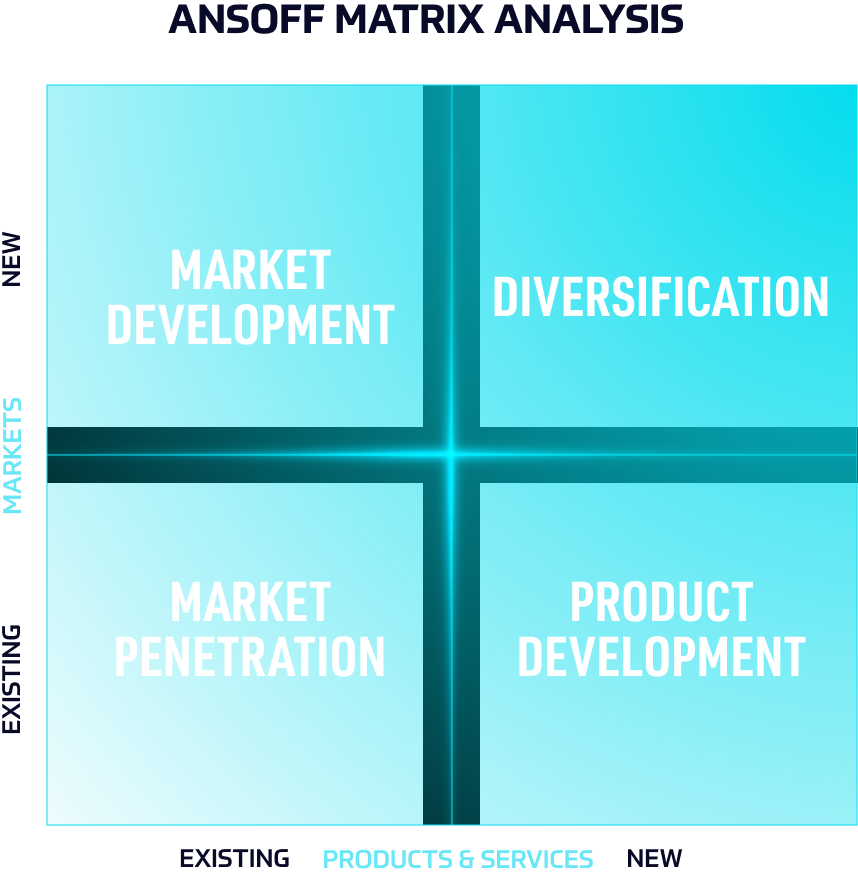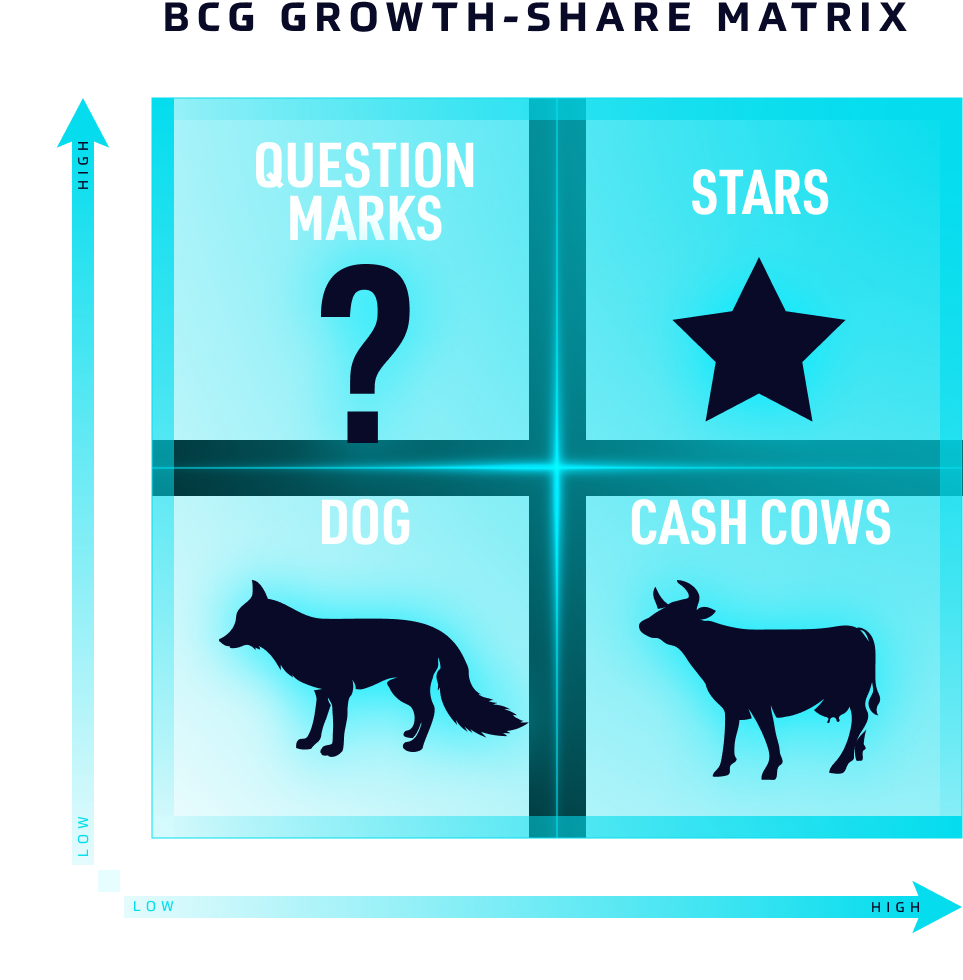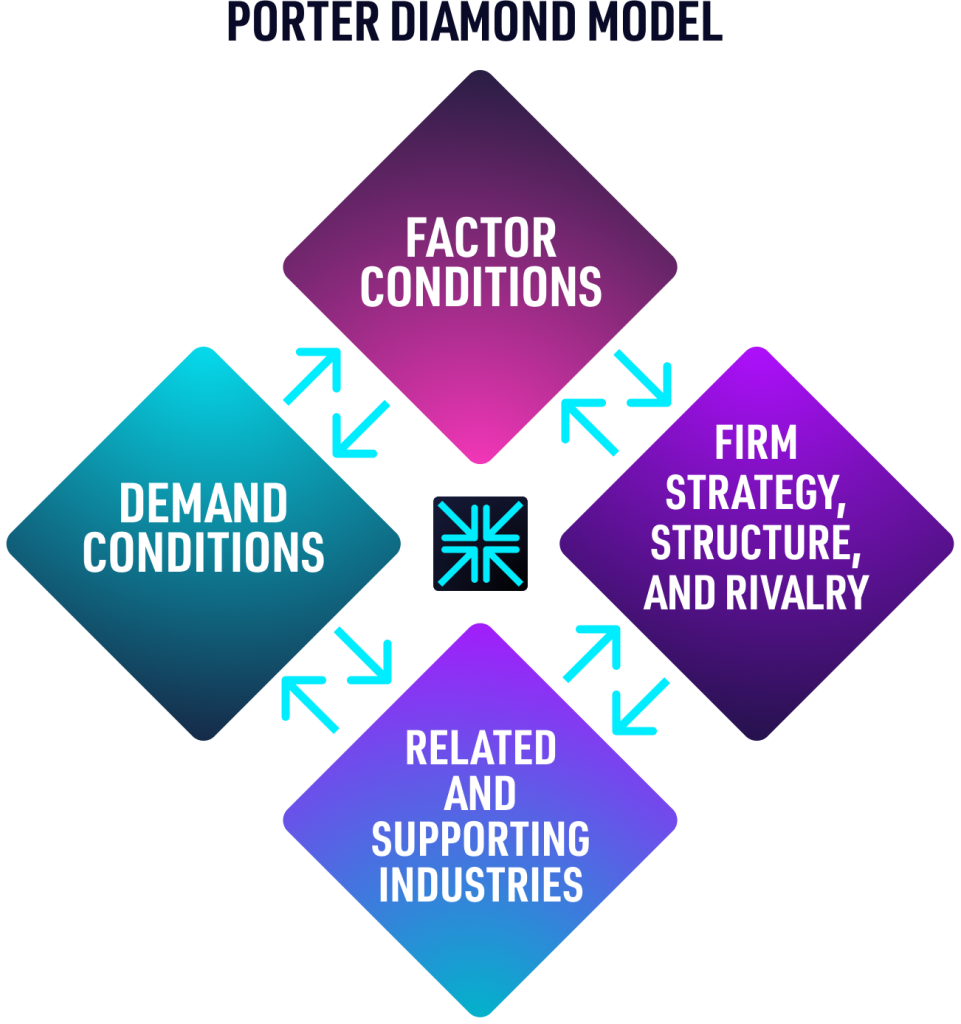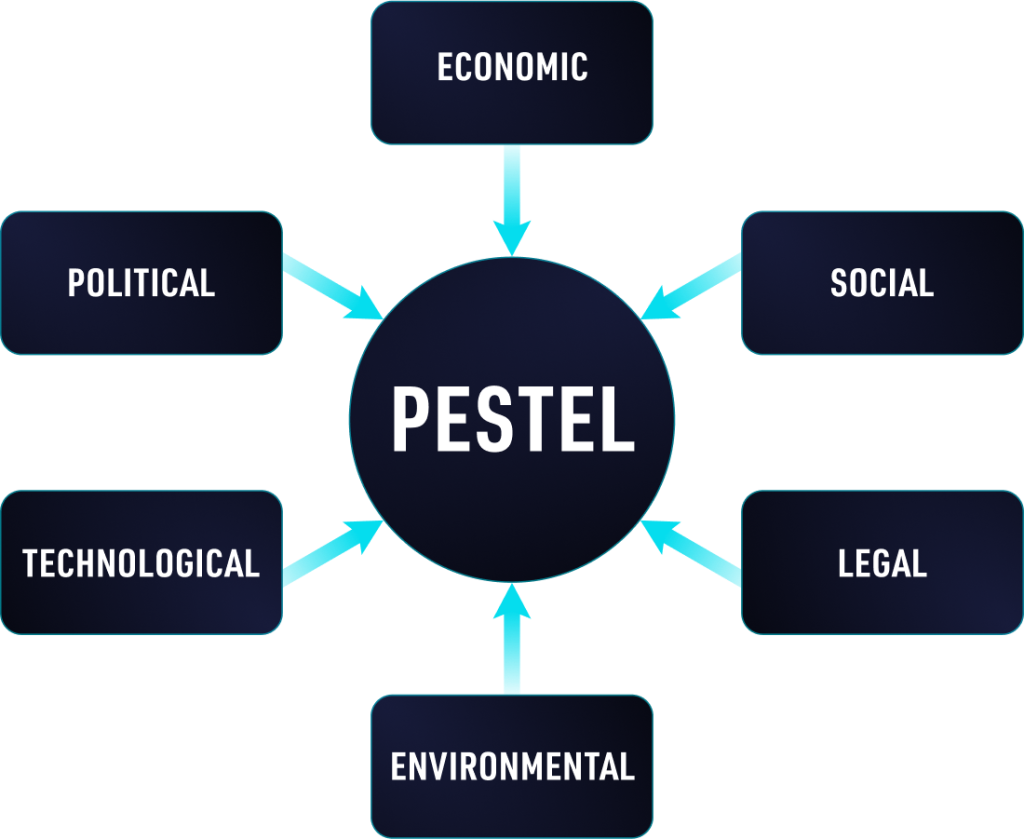5 business strategy frameworks for business growth
Business Strategy Framework #1 ANSOFF MATRIX ANALYSIS
The Ansoff Matrix is a business strategy framework and a planning tool that provides managers with a template to devise strategies for future growth.

There are 4 growth strategies within the Ansoff Matrix:
- Market penetration strategy = in which the company seeks to improve business performance either; by increasing the volume of sales to its present customers or by finding new customers for present products;
- Market development strategy = in which the company sells its existing products to new markets;
- Product development strategy = in which the company develops new products for the same market;
- Diversification strategy = in which the company develops new products in a new market.
What growth strategies does Apple use?
Learn from our Ansoff Matris analysis of Apple.
Business Strategy Framework #2 BCG GROWTH-SHARE MATRIX
The BCG Growth-Share Matrix helps companies analyze their business units (i.e. their product lines) or any other cash-generating entities by their degree of profitability.
This business strategy framework provides the company with a four-quadrant chart where products are ranked on the basis of their relative market shares and growth rates:
“cash cows”,
“dogs”,
“question marks” and
“stars”.

Cash cows are products in low-growth areas for which the company has a high market share.
Products with a low market share in areas with slow growth are dogs.
Question marks are the products with a low market share in a high growth rate market.
Stars are products with a high market share in a high growth rate market.
To show how you can use the matrix for your business, read our analysis of e-commerce leader Amazon, specifically four of its products: Amazon AWS, Amazon Video, Amazon Live and Amazon Echo with Alexa.
Business Strategy Framework #3 PORTER DIAMOND MODEL
The Porter Diamond Model is a business framework that describes a nation’s competitive advantage in the international market.
It also refers to innovation and why certain companies based in certain nations are capable of consistent innovation.

The 4 attributes of the Porter’s Diamond Model:
Factor Conditions = defines the nation’s position in factors of production, such as labour, land, natural resources, capital or infrastructure, necessary to compete in a given industry.
Demand Conditions = refers to the nature of home-market demand for the industry’s product or service.
Related and Supporting Industries = reveals the presence or absence in the nation of supplier industries and other related industries that are internationally competitive.
Firm Strategy, Structure, and Rivalry = highlights the conditions in the nation governing how companies are created, organized, and managed, as well as the nature of domestic rivalry.
Curious to see Porter’s Diamond Model applied to two leading brands?
Read Porter’s Diamond Model Analysis – Louis Vuitton and BMW.
Business Strategy Framework #4 PESTEL
PESTEL business analysis is a framework for helping entrepreneurs and business people to understand the impact of macro-environmental factors on their businesses.
The PESTEL acronym stands for 6 factors: POLITICAL, ECONOMIC, SOCIAL, TECHNOLOGICAL, ENVIRONMENTAL, and LEGAL.

Political factor = helps you appraise the degree to which a government intervenes in the economy or a certain industry.
Economic factor = examines the economic growth, exchange rates, interest rates, unemployment rates, the state of the country’s infrastructure, and taxes.
Social factor = analyzes the profile and behaviour patterns of your customers.
Technological factor = lists the technologies impacting your industry and whether they are or not favourable.
Environmental factor = takes into account any negative impact your company operations have on the environment and prompts your company to reduce the carbon footprint, reduce waste and pollution, and preserve the environment.
Legal factor = looks into the laws and regulations of your industry.
Not sure how to apply the framework to your business?
Read A Pestel Analysis of Nike.
Business Strategy Framework #5 PORTER’S 5 FORCES
Porter’s 5 Forces framework is a valuable business tool that helps entrepreneurs shape their strategy to drive profitability.

Porter’s 5 forces are:
1. Existing rivals = Evaluate the existing rivals by looking at the number of competitors, their size and power, the industry growth rate and product differentiation.
2. Buyers = The buyers are powerful and can influence the industry if they make purchases in large volumes. Are they price-sensitive? Do they have many alternatives to buy from?
3. Suppliers = Factors in determining supplier power: number of suppliers and concentration, switching costs, availability of substitutes, uniqueness of product, whether or not the industry is an important customer of the supplier and its availability to cut out the middleman.
4. Substitutes = Substitutes are alternative products that fulfil the same need by different means. In the airline industry, the substitutes are trains and cars.
5. New rivals = Is it easy for new rivals to enter the industry? If the entry barrier is low, which means requirements to enter the industry are affordable or readily accessible, then there are increasing chances of new entrants in great numbers. In this case, the threat is high.
Attend the BUSINESS STRATEGY MASTERCLASS, on October 27, and learn strategic business moves from Costas Markides, Professor of Strategy & Entrepreneurship at London Business School.

5 steps to create a strategic plan that will support your business vision
In this article:
-
What is strategic planning in business: definition of the strategic plan, who creates a strategic plan, the main goal of a strategic plan;
-
Strategic plan vs Business plan;
-
Benefits of strategic planning;
-
The strategic planning process: 5 steps to create a strategic plan that will support your business vision.
1. What is strategic planning in business?
Strategic planning is an organizational management activity. The company’s CEO and senior leadership team are tasked with creating a strategic plan, it’s one of their responsibilities.
The goal of a strategic plan is to provide you with a roadmap to align the organization’s functional activities to achieve set goals and determine the direction in which you want to take your business.
The plan outlines what (resources), how (specific tools, activities, platforms etc) and why (the reasons behind your choice of a specific resource or tool) the company will use to achieve its goals.
The main goal of your strategic plan is differentiation
The main goal of the strategic plan you create for your business is to define how your business differentiates itself from the competition.
What activities is your business performing that are different from the activities performed by your competitors?. Or what activities that are similar to your competitors’ you perform differently?
Harvard professor and author of Porter’s 5 Forces Michael Porter defines strategy as “performing different activities from others or performing similar activities in a different manner.”
Nikki Reed’s jewellery – a case study on business differentiation
Twilight series actress Nikki Reed designs beautiful jewellery. Her collections include 14-18 karat gold pieces. As opposed to other jewellery designers, her collections are made from e-waste.
Nikki’s business goal is to produce jewellery that is ethically made, sustainable and chemical-free. To achieve her goal, she partnered with computer technology company Dell.
According to the latest stats, it is estimated that our smartphones contain more than $60 million in gold and/or silver which are thrown away every year. Dell has developed a process for extracting gold from old computer motherboards that is 99% more environmentally friendly than extracting gold from the earth.
That’s how Nikki Reed differentiates her business from competitors: by using gold responsibly extracted from recovered technology to make beautiful jewellery. See her collections.
2. Strategic plan vs Business plan
A strategic plan is for established businesses looking to grow by providing them with focus, direction and action. Whereas a business plan is for businesses starting out and provides the entrepreneur with a structure for his ideas defining the business.
A strategic plan generally covers a period of 3 to 5+ years, whereas a business plan is normally no more than one year.
Discover more differences between a strategic plan and a business plan.
3. Benefits of strategic planning
No matter how much you wished your business had no competition on the market, your competitors are not going away just because you wish them to.
What you could do, after a thorough analysis of your business, the market and your competition is to devise a strategy that would help your business achieve its goals by doing things differently.
By having a strategic plan in place the top management conveys trust to the company’s employees.
A clear path to achieving set business goals means the team is more likely to enjoy an increased level of focus, determination and creativity.
Success is more easily achievable when everyone knows what to do and how to do it.
4. The strategic planning process
Before going into the strategic planning process, the CEO and top management have to be clear on the company’s vision, mission and organizational goals and objectives.
The CEO or founder is responsible for creating the vision and formulating the mission. The business vision states why you do it while the business mission states what your company does to achieve its vision.
The vision statement provides a snapshot of what the world would look like as a result of the company’s services. The mission statement is the roadmap for the company’s vision statement.
Let’s look at the vision and mission statements of a number of companies whose products and services you might use on a daily basis.
Vision – To provide access to the world’s information in one click.
Mission – Our mission is to organize the world’s information and make it universally accessible and useful.
AMAZON
Vision – We aim to be Earth’s most customer-centric company.
Mission – Our mission is to continually raise the bar of the customer experience by using the internet and technology to help consumers find, discover and buy anything, and empower businesses and content creators to maximize their success.
SALESFORCE
Vision – Salesforce is the world’s #1 customer relationship management (CRM) platform.
Mission – We bring companies and customers together. We help your marketing, sales, commerce, service and IT teams work as one from anywhere — so you can keep your customers happy everywhere.
Did you know? SalesForce has recently announced that it will acquire Slack for $27.7 billion.
TIKTOK
Vision – TikTok is the leading destination for short-form mobile video.
Mission – Our mission is to inspire creativity and bring joy.
5 steps to create a strategic plan that will support your business vision
A company’s vision and mission are not set in stone. Your business may transform as a result of technological developments or customer behaviour changes. For this reason, it is important to revisit the company’s vision and mission and amend them if necessary.
- Market analysis
- Development
- Implementation
- Review and update
- Evaluation and measurement
Step 1 – Market analysis
Before anything else, it is important to get updated on the current status of your business.
Perform a SWOT analysis to see if there are changes in your company’s strengths, weaknesses, opportunities and threats?
Are there new threats looming over the business ushered in by the pandemic?
Can you turn a new threat into an opportunity?
How is the pandemic affecting your bottom line?
Next, apply PORTER’s 5 Forces framework to your industry to evaluate how the pandemic is influencing the drivers of profitability and competition in your market. Get your team together and discuss what valuable insights you can take away from this analysis. How could these insights help you come up with a specific and unique way in which to delight your customers today?
PESTEL is another great tool that you can use to understand the impact of macro-environmental factors on your business. The PESTEL acronym stands for Political, Economical, Social, Technological, Environmental and Legal.
How are these factors that you cannot influence, affecting your business?
Check out a PESTEL analysis of Nike
Once you have drawn relevant insights from your company and business market analysis, you can move to step 2 of the strategic plan: development.
Step 2 – Development
Sit down together with your team and write the strategic plan.
Include the following:
- Company description
- Mission, vision and value statements
- Strengths, weaknesses, opportunities and threats
- Describe the current drivers of profitability and competition (PORTER’s 5 Forces)
- Describe how the macro-environmental factors impact your business (PESTEL)
- Prioritize your objectives
- Determine your strategic position (ie: at least one way in which your business will differentiate itself from the competition)
- Describe in great detail how you are going to leverage your newly developed strategy to achieve your business goals (means of communication, resources, budget etc)
- Include an execution timeline and how you are going to measure success
- Review and revise the plan.
Step 3 – Implementation
Now that you have the strategic plan on paper it’s time to execute it.
But before that, you need to communicate your plan to the employees that are going to implement it.
Choose the best way to do that. Is it a lengthy email? Or an all-hands meeting?
Prepare yourself to answer questions and convey your vision as clearly as possible.
You might also need to provide inspiration and motivation.
Step 4 – Review and Update
Determine when to review the strategic plan over the course of the implementation and go back to the plan to update it if necessary: 3 months? 6 months?
Step 5 – Evaluation and measurement
Once the strategic plan has been executed, it’s time for evaluation and measurement.
Extract the results and measure them against your set projections.
Calculate the KPIs and ROI.
Did the strategic plan help your business to achieve its set objectives?
Join the Conversation
We’d love to hear what you have to say.
Get in touch with us on our LinkedIn Page, Facebook Page, Twitter or TikTok.
